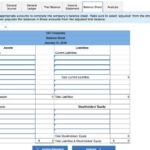
Similarly, if you make a sale, the amount is credited to the sales account. For example, consider receiving a check for $5,000 as a vehicle insurance provider. To account for this transaction, $5,000 is entered into the insurance account as a debit. You can hire an accountant and bookkeeper to do your business’s double-entry bookkeeping. Or, FreshBooks has a simple accounting solution for small business owners with no accounting background.
Liabilities – The Accounting Equation: Assets, Liabilities, and Equity
Temporary accounts include revenue and expense accounts, which track activity for a specific accounting period. At the end of the period, their balances are closed to the Retained Earnings account. Permanent accounts, such as asset, liability, and equity accounts, carry forward their balances from one period to another. Transactions are recorded using debits and credits, representing the two sides of each transaction. Debits are recorded on the left side of an account, while credits are recorded on the right side. Both debits and credits can either increase or decrease the balance of an account, depending on the account type.
Reconciliation ensures that all transactions have been properly recorded and accounted for, uncovering inconsistencies or omissions. Neglecting reconciliation can result in incorrect financial statements and misinterpreting the company’s financial position. Total the debit and credit columns separately and ensure that the totals match. For liability and equity accounts, increases net sales overview formula and components income statement are recorded as credits, and decreases are recorded as debits.
Control Accounts – Accounts: Types and Classifications
Liability accounts that limit activity represent the company’s obligations or debts to external parties. These obligations arise from loans, accounts payable, accrued expenses, and other financial obligations. Liability accounts are classified into current liabilities and long-term liabilities. Examples of liability accounts include Accounts Payable, Loans Payable, Notes Payable, Accrued Expenses, and Deferred Revenue. The list is split into two columns, with debit balances placed in the left hand column and credit balances placed in the right hand column. Another column will contain the name of the nominal ledger account describing what each value is for.
Inadequate Control over Journal Entries – Common Challenges and Errors in Double-Entry Bookkeeping
By employing double-entry bookkeeping, businesses can 16 payroll quizzes online trivia questions and answers maintain accurate and reliable financial records. Each transaction is recorded with corresponding debit and credit entries, ensuring that all financial activities are properly documented. It ensures financial records’ accuracy and completeness by capturing the source and destination of every transaction. It enables the creation of financial statements such as the balance sheet, income statement, and cash flow statement, which are essential for evaluating the financial health of a business. Additionally, it facilitates the identification and correction of errors, as any discrepancy in the balance of accounts indicates a mistake in the recording.
Additionally, double-entry bookkeeping enables the identification and analysis of various financial ratios and metrics. These ratios, such as liquidity, profitability, and solvency, help assess the company’s financial health, performance, and stability. Financial statement users, including investors, creditors, and stakeholders, rely on these statements and ratios to make informed decisions and evaluate the company’s financial performance.
Liabilities are also worth $25,000, which, in this case, comes in the form of a bank loan. Single-entry bookkeeping is much like the running total of a checking account. You see a list of deposits, a list of purchases, and the difference between the two equals the cash on hand. For very small businesses with only a handful of transactions, single-entry bookkeeping can be sufficient for their accounting needs. As a small business owner, knowing which accounting practices you should use can be confusing.
- Double-entry bookkeeping is an important concept that drives every accounting transaction in a company’s financial reporting.
- It enables the creation of financial statements such as the balance sheet, income statement, and cash flow statement, which are essential for evaluating the financial health of a business.
- Double-entry bookkeeping ensures that financial records are complete, balanced, and aligned with accounting standards and regulations.
There are two different ways to record the effects of debits and credits on accounts in the double-entry system of bookkeeping. Irrespective of the approach used, the effect on the books of accounts remains the same, with two aspects (debit and credit) in each of the transactions. Conduct bank reconciliations, accounts receivable/payable reconciliations, and inventory reconciliations monthly or quarterly. These reconciliations help identify discrepancies and errors, ensuring the accuracy of financial records. Create detailed SOPs that outline the steps for recording transactions, reconciling accounts, and generating financial statements.

Similarly, for expense accounts, increases are recorded as debits, and decreases are recorded as credits. When an expense is incurred, such as paying for rent or purchasing supplies, the respective expense account is debited, increasing the expense. To ensure that the books are balanced, the total debits must equal the total credits for each transaction. If the totals do not match, it indicates an error or omission in recording the transaction. Liabilities represent the company’s obligations or debts to external parties.
